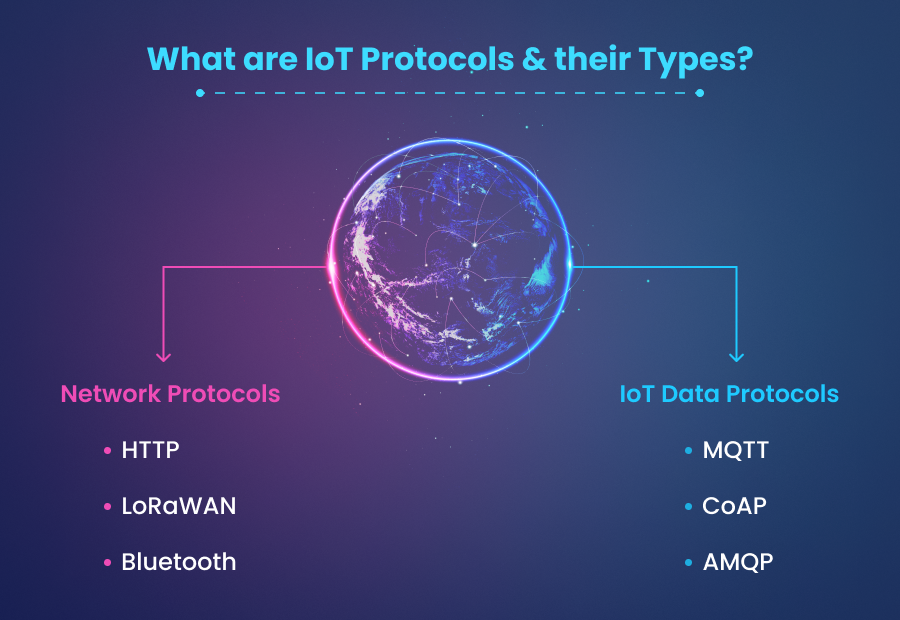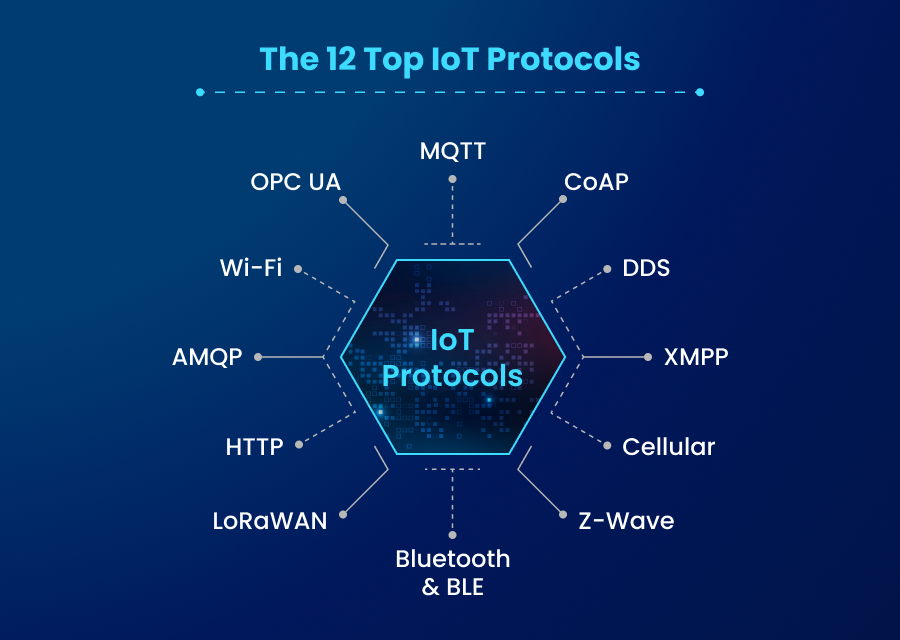By 2025, there will be 25 billion connected IoT devices in the world. Millions of connected devices will communicate at one time, share data, transfer information, and take action. With all these connections taking place, IoT protocols and communication standards are mission-critical to manage and administer all the connections.
With the development of IoT devices, their communication standards are also progressing. There has been a substantial expansion in LPWA networks to the amount of 61% year-on-year growth, people have started using the 5G network, and many other developments are taking place. In this article, we will talk about different IoT protocols and Communication Standards used in IoT-connected devices.
What are IoT Protocols and their Types?
The term protocol defines the set of rules and guidelines used for formatting and processing data. These protocols act as a common language for connected devices and computers to communicate. Not every computing device is built with the same hardware and software, but they may have to communicate at some point.
This is where protocols come into play and allow different devices to communicate and connect seamlessly. IoT protocols refer to the communication system whereby different IoT devices can connect and communicate.

Hence, these IoT protocols are as imperative to the entire structure as an IoT device itself. Moreover, it must be understood that not all protocols are created equal. They are built with different purposes and are able to channel different communication systems. There are IoT communication standards that work well for devices located within a building, while others are meant to administer cross-continent connections and everything in between.
There are two types of IoT protocols;
Network Protocols
Network IoT protocols help devices connect over the network, and they are generally used over the internet. IoT protocols in this category are able to process end-to-end data communication within the predefined scope of the network. The most popular network protocols are HTTP, LoRaWan, Bluetooth, etc.
IoT Data Protocols
The IoT Data protocols play an important role in connecting low-power IoT devices. These protocols help establish point-to-point communication with the device hardware on the client’s end. IoT data protocols can also allow devices to connect without the internet. Popular IoT data protocols include MQTT, CoAP, AMQP, etc.
Here are the 12 Top IoT Protocols
All the protocols work on the basis of an IoT architecture. This architecture underlines the development of networking systems built on a stack of different technologies and are frequently visualized in a framework. The developers and technologies use this framework to conceptualize how data travels through the entire stack, building connections and communication channels.

These connections are then defined with the help of different layers;
- Three-layer models include Perception, Network, and Application.
- Four-layer model includes Perception, Support, Network, and Application.
- Five-layer model includes Perception, Transport, application, and business, processing OR Physical, Application, Transport, Network, and Data Link.
MQTT
Message Queuing Telemetry Transport came out in 1999, and it is used for M2M communication with the help of publish-subscribe architecture. The purpose is to establish communication between different devices, but it also works with constrained devices. MQTT is specifically built to enable communication among devices in low-bandwidth areas where the mobiles and sensors are running on unreliable networks. Even though MQTT began working as a proprietary protocol, today it’s a leading open-source protocol used in IoT and IIoT devices.
CoAP
Constrained Application Protocol (CoAP) is a web transfer protocol and is used under three conditions;
- Limited networks
- Low bandwidth
- Low availability
Based on the client/server architecture, CoAP supports the REST model and makes the required resources available with the URL. Moreover, the clients can make requests of different types, including GET, POST, PUT, and DELETE, with CoAP. The basic purpose of CoAP is to help establish connections in highly congested networks.
DDS
Data Distribution Service is meant to be used for real-time systems. It’s a middleware protocol and an API standard providing better data connectivity. The DDS protocol integrates different components of a system together and provides low-latency data connectivity. As a result, the connection between devices is secure and reliable. Moreover, it works on a scalable architecture, which is important for IoT applications.
AMQP
Advanced Message Queuing Protocol is used for sending and receiving transactional messages between different servers. It’s a standard application layer protocol and has three main functions. These are receiving and placing messages in a queue, storing the messages, and establishing a relationship between different components. AMQP is highly reliable and secure, which makes it a common IoT communication protocol used in the banking industry. However, in other industries, AMQP is not so popular because of its heavy memory requirements.
XMPP
Extensible Messaging and Presence Protocol exchange messages between devices and connections in real time. It’s a flexible communication standard and protocol and is used as an availability or presence indicator for the servers. In other words, XMPP helps identify whether the connections between servers and devices transmitting messages are working properly.
OPC UA
OPC Unified Architecture is specifically made for communication at the industrial level. The protocol is built to ensure seamless interoperability between manufacturers and their operating systems running the machines and equipment. This is a transport-agnostic protocol that is compatible with previous and new architectures, including requests/responses like websocket or HTTP and publish or subscribe.
Bluetooth and BLE
Bluetooth might be the most common IoT and communication protocol a non-technical person has heard of, as they use it in their daily lives. Bluetooth represents a short wavelength and ultra-high frequency radio waves communication protocol used for different purposes. This includes audio streaming, transfer of data, etc. Bluetooth is a low-power consumption communication standard, but it also has low-range connectivity. A new version of Bluetooth is BLE (Bluetooth Low Energy) which is a better version meant to administer IoT connections. BLE uses even less energy than bluetooth and this makes it a good choice for fitness trackers and smart home devices.
Cellular
Cellular networks are also used for establishing connections between IoT devices and peripherals. Currently, most IoT devices rely on 4G cellular network protocol, but as 5G becomes more prevalent, the devices will take no time to switch. These networks consume more power than other protocols, but they are also super important. To establish cellular network connectivity, a SIM card is required. These connections have low latency and provide the benefit of high-speed data transfer.
LoRAWAN
Long Range WAN also classifies as a media access control (MAC) IoT protocol. The primary benefit of LoRaWAN is that it allows low-powered devices to communicate directly with internet-connected devices and connections. As the name suggests, LoRaWAN builds these connections over a long range. LoRaWAN is built on top of LoRA radio module technology. With this, LoRaWAN allows devices to connect and communicate while managing the connection between the end-node devices and network gateways.
Wi-Fi
Wireless Fidelity (Wi-Fi) network is used extensively in home, commercial and industrial buildings, and it’s a frequently used IoT protocol. Wi-Fi offers high-speed data transfer and provides a larger capability of processing large amounts of data. Mostly, Wi-Fi is best suited for LAN environments and works effectively well in short to medium-range distances. Having said that, Wi-Fi networks are power-consuming, which makes deployment for every use case a bit difficult. Moreover, Wi-Fi has a lower range, and its scalability is also less than optimum.
Z-Wave
Z-Wave is a wireless mesh network built to provide connectivity with low-power radio frequency systems. Z-wave is similar to Wi-Fi and Bluetooth as it lets devices communicate with an encrypted connection. So, the level of security and connectivity is higher than others in Z-Wave. Mostly, the Z-Wave IoT protocol is used for home automation security systems, and it also has several industrial-grade applications.
HTTP
Hypertext Transfer Protocol has been around since the inception of data communication over the WWW ecosystem. Due to its global acceptance, HTTP is used in the IoT world and administers communication. With HTTP, two devices can communicate with each other and share information, but no other device can be added to the mix.
Conclusion
Connections and connected devices over an IoT network need to communicate and transfer data between each other for better communication. To administer and manage the communication, some standard communication protocols are used, which define how a connection will be established. It will also determine the speed of data transfer, security, reliability, and scalability. Hence, choosing the right IoT protocol for communication is crucial. Confused about how IoT and its protocols can play a crucial role in your organization, Contact Us, and we can help you with the answer.
The post IoT protocol and commnication standards appeared first on Datafloq.

